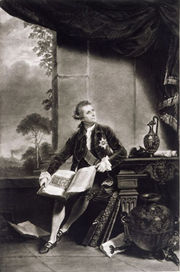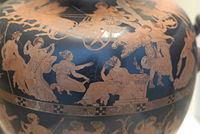
Meidias Painter
Encyclopedia

Athens
Athens , is the capital and largest city of Greece. Athens dominates the Attica region and is one of the world's oldest cities, as its recorded history spans around 3,400 years. Classical Athens was a powerful city-state...
red-figure vase
Pottery of Ancient Greece
As the result of its relative durability, pottery is a large part of the archaeological record of Ancient Greece, and because there is so much of it it has exerted a disproportionately large influence on our understanding of Greek society...
painter in Ancient Greece
Ancient Greece
Ancient Greece is a civilization belonging to a period of Greek history that lasted from the Archaic period of the 8th to 6th centuries BC to the end of antiquity. Immediately following this period was the beginning of the Early Middle Ages and the Byzantine era. Included in Ancient Greece is the...
, active in the last quarter of the fifth century BCE
5th century BC
The 5th century BC started the first day of 500 BC and ended the last day of 401 BC.-Overview:This century saw the beginning of a period of philosophical brilliance among Western civilizations, particularly the Greeks which would continue all the way through the 4th century until the time of...
(fl. c. 420 to c. 400). He is named after the potter whose signature is found on a large hydria
Hydria
A hydria is a type of Greek pottery used for carrying water. The hydria has three handles. Two horizontal handles on either side of the body of the pot were used for lifting and carrying the pot. The third handle, a vertical one, located in the center of the other two handles, was used when...
of the Meidias Painter’s decoration (BM E 224), excavated from an Etruscan
Etruria
Etruria—usually referred to in Greek and Latin source texts as Tyrrhenia—was a region of Central Italy, an area that covered part of what now are Tuscany, Latium, Emilia-Romagna, and Umbria. A particularly noteworthy work dealing with Etruscan locations is D. H...
tomb. Eduard Gerhard first identified this inscription in 1839, and it was he who determined the scene on the vase was the rape of the daughters of Leukippos
Leucippus (mythology)
In Greek mythology, Leucippus, son of Gorgophone and Perieres, was the father of Phoebe and Hilaeira, and also of Arsinoe, mother of Asclepius, by his wife Philodice, daughter of Inachus....
where previously it was thought to be the race of Hippomenes
Hippomenes
In Greek mythology, Hippomenes , also known as Melanion, was the husband of Atalanta.- Overview :When men who were struck by Atalanta's beauty watched her run through the forest, she became angry and told them "I will race anyone who wants to marry me! Whoever is so swift that he can outrun me will...
and Atalanta
Atalanta
Atalanta is a character in Greek mythology.-Legend:Atalanta was the daughter of Iasus , a Boeotian or an Arcadian princess . She is often described as a goddess. Apollodorus is the only one who gives an account of Atalanta’s birth and upbringing...
. The Meidias Painter’s work bears a close similarity to his older contemporaries the Kodros Painter, the Eretria Painter and Aison
Aison (vase painter)
Aison was an ancient Greek vase painter of the red-figure style. About 60 of his vases survive, which are dated between 435 and 415 BCE. Aison spent his career in several workshops, where he came into contact with several other well known painters. His first works were created in the same workshop...
; these last two have both been suggested for his teacher. Indeed it has also been suggested that works ascribed to the Meidias Painter are in fact late works by Aison. John Beazley
John Beazley
Sir John Davidson Beazley was an English classical scholar.Born in Glasgow, Scotland, Beazley attended Balliol College, Oxford, where he was a close friend of the poet James Elroy Flecker. After graduating in 1907, Beazley was a student and tutor in Classics at Christ Church, and in 1925 he...
attributed 22 vases and fragments to the Meidias Painter with a further 2 possible ascriptions, certain attribution is complicated by the large number of followers the ornate style of the Meidias Painter engendered. His school includes 9 individually identifiable artists or groups; the total number of distinct vases Beazley gives to the Meidias Painter and his circle is 192. The latest catalogue raisonné
Catalogue raisonné
The typical catalogue raisonné is a monograph giving a comprehensive catalogue of artworks by an artist.The essential elements of a catalogue raisonné are that it purports to be an exhaustive list of works for a defined subject matter describing the works in a way so that they may be reliably...
list 36 vases by the Meidias Painter, 34 by named followers and 167 under the "manner of the Meidias Painter".

Lekythos
A lekythos is a type of Greek pottery used for storing oil , especially olive oil. It has a narrow body and one handle attached to the neck of the vessel. The lekythos was used for anointing dead bodies of unmarried men and many lekythoi are found in tombs. The images on lekythoi were often...
, choes and a variety of pyxides
Pyxis (pottery)
A pyxis is a shape of vessel from the classical world, usually a round box with a separate lid. Originally mostly used by women to hold cosmetics, trinkets or jewellery, surviving pyxides are mostly Greek pottery, but especially in later periods may be in wood, metal, ivory, or other materials...
and lekanides preferred for smaller pieces. Meidian figures are recognizable by their long profiles, large eyes, small mouths, rounded chins and the frequency of the three-quarters portrait. His women are slim and long-limbed, his men incline to plumpness, and both enjoy tapering fingers and toes. He pays particular attention to the details of clothing, jewellery and hair; all his women wear earrings, necklaces, hair ornaments and bracelets, their hair rendered with individual locks and elaborate coiffure and their dress usually a diaphanous, multi-pleated peplos
Peplos
A peplos is a body-lengthGreek garment worn by women before 500 BC. The peplos is a tubular cloth folded inside-out from the top about halfway down, altering what was the top of the tube to the waist and the bottom of the tube to ankle-length. The garment is then gathered about the waist and the...
, which billows with a flourish. His subject matter favours the mythological over the historical (the birth of Erichthonios
Erichthonius of Athens
King Erichthonius was a mythological early ruler of ancient Athens, Greece. He was, according to some legends, autochthonous and raised by the goddess Athena. Early Greek texts do not distinguish between him and Erectheus, his grandson, but by the fourth century B.C...
is a recurring theme) and given that he worked at the height of the Peloponnesian War
Peloponnesian War
The Peloponnesian War, 431 to 404 BC, was an ancient Greek war fought by Athens and its empire against the Peloponnesian League led by Sparta. Historians have traditionally divided the war into three phases...
have the air of escapist fantasy.
The Meidias Painter’s name vase and chef-d’œuvre belonged originally to the first collection of Sir William Hamilton
William Hamilton (diplomat)
Sir William Hamilton KB, PC, FRS was a Scottish diplomat, antiquarian, archaeologist and vulcanologist. After a short period as a Member of Parliament, he served as British Ambassador to the Kingdom of Naples from 1764 to 1800...
. This vase featured prominently in his portrait by Joshua Reynolds
Joshua Reynolds
Sir Joshua Reynolds RA FRS FRSA was an influential 18th-century English painter, specialising in portraits and promoting the "Grand Style" in painting which depended on idealization of the imperfect. He was one of the founders and first President of the Royal Academy...
and proved to be a significant influence on the neoclassical
Neoclassicism
Neoclassicism is the name given to Western movements in the decorative and visual arts, literature, theatre, music, and architecture that draw inspiration from the "classical" art and culture of Ancient Greece or Ancient Rome...
movement. It also took pride of place in d’Hancarville
Pierre-François Hugues D'Hancarville
Pierre-François Hugues d'Hancarville was a French pseudo-aristocrat . Son of a bankrupt cloth merchant of Nancy, Hancarville was born Pierre-François Hugues, adding the title ‘Baron’ and the aristocratic surname Hancarville himself...
’s folio album Collection of Etruscan Greek, Roman Antiquities from the Cabinet of the Honourable William Hamilton, vol. I, 1766 (plates 127-130). It was reproduced on Wedgwood
Wedgwood
Wedgwood, strictly speaking Josiah Wedgwood and Sons, is a pottery firm owned by KPS Capital Partners, a private equity company based in New York City, USA. Wedgwood was founded on May 1, 1759 by Josiah Wedgwood and in 1987 merged with Waterford Crystal to create Waterford Wedgwood, an...
jasperware
Jasperware
Jasperware, or jasper ware, is a type of stoneware first developed by Josiah Wedgwood, although some authorities have described it as a type of porcelain...
, on furniture and in paintings, and extravagantly praised by Winckelmann as “the finest and most beautiful drawing in the world”. It was acquired by the British Museum
British Museum
The British Museum is a museum of human history and culture in London. Its collections, which number more than seven million objects, are amongst the largest and most comprehensive in the world and originate from all continents, illustrating and documenting the story of human culture from its...
in 1772.
Sources
- H. Nicole: Meidias et le style fleuri, 1908.
- J. D. Beazley: Attic Red-figured Vases in American Museums, 1918.
- W. Hahland: Vasen um Meidias, 1930.
- G. Becatti: Meidias: Un manierista antico, 1947.
- L. Burn: The Meidias Painter, 1987
- J. Boardman: Athenian Red Figure Vases, the Classical Period, 1989.
- T. Mannack: The Late Mannerists in Athenian Vase Painting, 2001.

